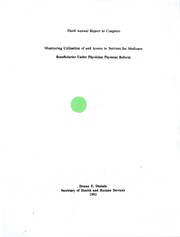
Report to Congress : monitoring utilization of and access to services for Medicare beneficiaries under physician payment reform PDF
Preview Report to Congress : monitoring utilization of and access to services for Medicare beneficiaries under physician payment reform
ThirdAnnualReporttoCongress MonitoringUtilizationofandAccesstoServicesforMedicare BeneficiariesUnderPhysicianPaymentReform DonnaE.Shalala SecretaryofHealthandHumanServices 1993 . Acknowledgments ThisreportwaspreparedintheOfficeofResearchandDemonstrations(ORD),Health CareFinancingAdministration. MarianGornickandWilliamSobaskiwereresponsible fortheoveralldesignandtechnicaloversightofthereport. AnneTrontell,M.D.,was alsoresponsiblefortechnicaloversight. Dataanalysesandchapterswerepreparedby WilliamSobaskiandAnnMeadow(Chapter2);PaulEggers,Ph.D(Chapter3); MarianGornickandMarshallMcBean,M.D.(Chapter4);LawrenceKucken (Chapter5datafilebyJulieSchoenman,Ph.D..andKeithUmbelfromProjectHope); MargoRosenbach,Ph.D.,andJoyceHuber,Ph.D.,fromtheCenterforHealth EconomicsResearch,undergrant#90037/1 (Chapter6);ReneeMentnech(Chapter 7);andJoanWarren,Ph.D.(Chapter8). Severalindividualsprovidedreviewand commentsincludingAlmaMcMillan,JamesLubitz,SherryTerrell,Ph.D.,and HarrySavitt,Ph.D. ThereportwaspreparedunderthedirectionofGeorgeSchieber, Ph.D.,Director,OfficeofResearchandJosephR.Antos,Ph.D.,Director,Officeof ResearchandDemonstrations. TheBureauofDataManagementandStrategy providedcomputersystemsanalysisandprogrammingsupport,including MarilynNewton,RonaldPrihoda,MaeRobinson,andLynneRabey,underthe directionofRobertMoore,Director,OfficeofStatisticsandDataManagement. Data supportforChapter2wasprovidedbyBensonDutton,JesseLevy,andSamMcNeill (ORD);DianaVerrilli(UrbanInstitute);andStephenD.HardenandGeorgeI. Kowalczyk(HKReserchCorporation). GaryOlin,Ph.D.SusanThomasandYoung ParkofFuAssociatesprovidedanalyticandprogrammingsupportforChapter7. CherylHickmanwasresponsibleforthepreparationofthemanuscript. EXECUTIVESUMMARY TheOmnibusBudgetReconciliationAct(OBRA)of1989mandatedthedevelopmentof anewpaymentsystemforphysicians'servicespaidforbytheMedicareprogram. There arethreemajorcomponentsoftheOBRA1989reforms: thedevelopmentofa MedicareFeeSchedule(MFS);restrictionsonphysicians'abilitytobillMedicare beneficiariesforamountsabovetheMFS;andtheestablishmentoftargetratesof growthforexpendituresforphysicians'services. TheMFSwasimplementedon January1, 1992,undera4-yeartransitionperiodwiththelargestproportionoffee schedulechangesimplementedin1992. TheMFSisexpectedtohavetheeffectof shiftingMedicarepaymentstowardprimarycareservicesandtowardruralareas. Preliminary1992dataanalysesshowthatthegreatestexpectationsarebeingrealized. A greatershareofpaymentsflowedfromprocedure-orientedservices(surgery,anesthesia, assistantsatsurgery,diagnosticX-ray)towardprimarycare-orientedservices(medical care,consultation)andfromareaswherephysicians'earningswerehigher(e.g., California)towardareaswherephysicians'earningswerelower(e.g.,Mississippi). Relativeratesofphysicianservicesbydemographicandgeographiccategoriesremained unchanged;theMFSdoesnotappeartohaveexacerbatedanyofthedifferentialsthat mayhaveexistedinthebaselineperiod. E-1 OBRA1989requirestheSecretaryofHealthandHumanServicestomonitorandreport annuallytoCongressonchangesinutilizationandaccess,bypopulationgroups,by geographicarea,andbytypeofservice;andonpossiblesourcesofinappropriate utilization. ItisimportanttorecognizethattheOBRA1989reformsarepartofa continuumofchangesthathaveoccurredinMedicarepaymentpolicies. Initiatives precedingtheMFS,suchasthereductionsinprevailingchargesforoverpriced proceduresinstitutedforonegroupofproceduresin1989andforanothergroupin 1990,havehadanimpactinearlieryearsandarelikelytocontinuetoinfluenceaccess andutilization. Moreover,forcescontinuetoinfluencethedemandforandthesupply ofphysicians'servicesnotdirectlyrelatedtoMedicarepaymentpolicy. This1993reportisthethirdannualreporttoCongressonutilizationandaccessto servicesundertheMFS. Thereportusesmeasuresof"realized"access(suchas utilizationrates)and"potential"access(suchashavingaregularsourceofcare). Atthe timethe1992reportwasbeingprepared,theMFShadbeenineffectforonlyafew months;thus,datawereunavailabletoanalyzeanychangesinaccessthatmayhave occurred. Thisreportisthefirsttocontain1992data,albeitinapreliminarystate. Medicareadministrativeclaimsdata,whichcontainabundantinformationontheuseof PartBservices,arebeingusedtocreatemonitoringfiles. Filesarebeinggeneratedto monitorPartBserviceswiththephysicianspecialty,typeofservice,geographicarea,or thebeneficiaryastheunitofanalysis. Formonitoringbeneficiaryutilizationrates,a E-2 classificationsystemhasbeendevelopedthatgroupsallofthePartBbillingcodesinto 77broadcategories. Becausechangesinphysicianpaymentpolicymayalsoaffectaccess tosurgicalprocedures,procedurerateswillalsobemonitoredusingMedicarePartA administrativedata. TosupplementMedicaredata,twonationalsurveysarebeingusedtomonitorother indicatorsofaccess. Inaddition,theAreaResourceFileisbeingusedtomonitorthe supplyofphysicians. Thesedatabasesprovidedifferentperspectivesonissuesrelating toaccessandutilization. Differentdatasourceswillattimesshowsomewhatdiverse findingsthatarenotalwaysexplainable. Nonetheless,theuseofmultipledatasources providesmoreinsightintochangesthatmayoccurinaccessandutilizationthanthat providedbyasingledatasource. Thebasicanalyticalapproachusedinalloftheanalysesistocomparepatternsand trendsintheperiodsbeforeandaftertheOBRA1989physicianpaymentreformswere implemented. Vulnerablesubgroupsofthepopulationarebeingmonitored. Anumber ofgeographicgroupingsarealsobeingmonitored,includingareasexpectedtoundergo changesinpaymentsduetotheMFS. Toprovidearangeofperspectivesonaccessandutilization,sixseparateanalysesare presented. Chapters2and3employtheMedicarePartBmonitoringfilesandcontain preliminarydatafor1992. Thesedataarepreliminarybecausetheyreflectclaims E-3 informationreceivedinHCFAthroughDecember1992. Theotheranalysescontain datafromthebaselineperiod. Thenoteworthyfindingsreportedineachoftheanalyses aresummarizednext. Chapter2analyzesdatafromthePartBmonitoringfilescreatedwiththeprocedures, physicianspecialty,orthegeographicareaastheunitofanalysis. Thepreliminary1992 datashowthatthegreatestexpectationsfortheMFSarebeingrealized,thatis,a greatershareofMedicarepaymentsflowedfromprocedure-orientedservicestoward primarycare-orientedservices,andfromareaswherephysicianearningswerehigher towardareaswherephysicianearningswerelower. Amongbroadtypesofphysicianservices,thepreliminary1992dataindicatethat nationallytheshareofpaymentsforsurgeryservicesfellnearly8percent; foranesthesia andassistantsatsurgerythesharefellbyasimilarpercentage. Thesharefordiagnostic radiologyfellnearly5percent. Formedicalservicesthesharegrewbymorethan3 percentwhiletheshareforconsultationservicesgrewby25percent. Forthesebroadtypesofphysicianservices,thepreliminary1992dataindicatethatthe shareofpaymentsincreasedin15ofthe17Statesexpectedtohaveincreases,increased in8StatesandtheDistrictofColumbiawheredecreaseswereexpected;andincreased in10Stateswherevirtuallynochangewasexpected. PaymentsdecreasedinPuertoRico E-4 and15Statesexpectedtohavedecreasesandin2Stateswhereincreaseswereexpected. Accordingtothesepreliminary1992data,increasesinpaymentsweresubstantiallylarger thanexpected(i.e.,over5percent)ineightstates:Delaware,Mississippi,New Hampshire,NorthCarolina,SouthCarolina,Utah,VirginiaandWyoming;decreases weremuchlargerthanexpectedinCaliforniaandMaryland. Thedistributionofpaymentsamongphysicianspecialtieschangedaboutasexpected: theprimarycareproportionincreasedalmost11percent;theshareforallsurgicalMDs combinedfellbynearly4percent;theshareformedicalspecialtiesgrewbyabout1 percent;andtheproportionforotherMDspecialtiesfellabout1percent Thesedata indicatethatseveralnon-MFSservicesandprovidershadlarge(10percentormore) increasesintheirshares. Amongthesewereindependentlaboratoriesandambulance servicesuppliers. Thepreliminaryinformationwillbeupdated. Final1992figureswillbeincludedinnext year'sreport. Ananalysisofchangesinpracticepatternsamongasampleofphysicians willalsobeincludedinnextyear'sreport;theapproachisoutlinedinChapter2. TheanalysispresentedinChapter2examineschangesinthedistributionofpaymentsby eightbroadtypesofservices. Chapter3examineschangesinthedistributionofallowed E-5 chargesfor77broadtypesofservices. Thefindingsaresimilar:therewasasignificant shiftintherelativeshareofallowedchargesfromtheproceduralcategoriesofphysician servicestothemanagementandevaluationcategories. Chapter3presentspreliminary1992datafromthePartBmonitoringfilesthatwere createdtoanalyzechangesinutilizationwiththebeneficiaryastheunitofanalysis. In the1990baselineyear,Medicarebeneficiaries65yearsofageandoveraveragedabout 10.6physicianvisitsperperson,withofficevisitsaccountingfor46percentoftotalvisits andinpatienthospitalvisitsaccountingfor30percentofthetotal. Theremaining categoriesofvisitswereemergencyroom(3percent),nursinghome/home(5percent), specialist(13percent),andconsultations(4percent). In1990,therateofphysicians'visitsforpersons85yearsofageandoverwas99percent greaterthantherateforpersonsaged65to74. Thevisitrateforwomenwas8percent greaterthanformen. Thevisitrateforblackbeneficiarieswas2percentlowerthanthe rateforwhitepersons. Physicianvisitsperpersonwereabout14percentlowerinnon-metropolitanareasthan inmetropolitanareas. Rateswerehighestinthelargecorecountiesofmetropolitan areas. StatesinwhichtheMFSwasexpectedtodecreasephysicianpriceshadhigher ratesofphysicianvisitsper1,000beneficiariesthandidstatesinwhichpricesare E-6 expectedtoincreaseorinwhichthereisnoexpectedchange. Forthisreport,no analyseswereconductedbyHealthProfessionalShortageAreas. ThePartBbeneficiaryfileswereusedtotracktrendsover11calendarquarters,from 1990throughthethirdquarterof1992. Thepreliminarydataindicatethattherelative ratesofuseofphysician'svisitsandconsultations,byage,gender,raceandgeographic categorieshaveremainedunchanged,indicatingthatwiththedataavailabletodate,the MFSdoesnotappeartohavechangedaccesstocareortohaveexacerbatedthe differentialsthatexistedinthebaselineperiod. Chapter4examinesdifferencesinaccesstoselectedin-hospitalproceduresbyrace duringtheperiodprecedingtheimplementationoftheMFS. Selectedprocedureswere examinedtomonitoraccesstosurgicalservicesforavulnerablesubgroupofthe Medicarepopulation. BecausetheMFSwasdesignedtoshiftpaymentfrom procedure-orientedservicestowardprimarycare,baselineutilizationoftheseservicesis beingexamined. Proceduresexaminedinthisanalysisincluderelativelynewprocedures suchascoronaryarterybypassgraftaswellaswell-establishedproceduressuchas prostatectomy. Theanalysisindicatesthatinthebaselineperiod1986-1990,thenumberofdischarges per1,000enrolleeswashighereachyearforblackbeneficiariescomparedwithwhite beneficiaries. TherateofproceduresforblackMedicarebeneficiaries,however, was E-7 nearlyalwayslowerthantherateforwhitebeneficiaries. Differencesbyraceinthe procedureratestendedtobegreaterforthenewerand/ormoreelectiveproceduresand lessforthewell-establishedprocedures. Differencesin30-daypostadmissiondeath rateswerealsoexaminedbecausetheseratescanreflectdifferencesinqualityofcareor intheseverityofthepatientmix. Formostprocedures,the30-daydeathrateswere higherforblackbeneficiaries. Understandingthefactorsthatinfluencethesedifferences requiresinformationaboutmedicalneedandappropriatenessfortheseprocedures, whichisnotgenerallyavailable. Theseprocedureswillcontinuetobemonitoredasthe MFSisimplemented. Chapter5presentsananalysisofthesupplyofphysiciansintheU.S.duringtheperiod 1984-1990. Theanalysisshowsthatthesupplyoftotalphysicians,asmeasuredby physician-to-Medicarepopulationratios,increasedataslowbutsteadypaceduringthe studyperiod,risingfrom1,249physiciansper100,000beneficiariesin1984to1,325per 100,000in1990. ForeverytwophysiciansinamedicalspecialtyintheU.S.,therewas aboutonephysicianinasurgicalspecialty. Overthestudyperiodtheratioofphysicians inmedicalspecialtiestothoseinsurgicalspecialtiesrosefrom2.04to2.26,reflectingan increasingtrendinthesupplyofmedicalphysiciansrelativetosurgeons. In1990,thenumberofphysiciansper100,000beneficiariesinmetropolitanareaswas morethantwiceasgreatasthecorrespondingnumberinnon-metropolitanareas,with thelowestphysician-to-populationratiosoccurringinthinlypopulatednon-metropolitan E-8
